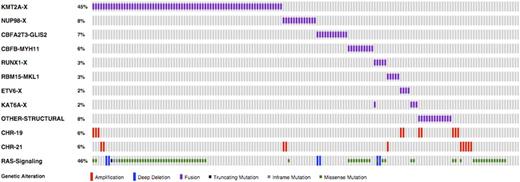Abstract
AML is a malignancy of hematopoietic progenitor cells characterized by differentiation arrest leading to hematopoietic insufficiency secondary to the accumulation of hematopoietic progenitors. While much is known about the karyotypic and immunophenotypic makeup of AML, comprehensive genomic data is still emerging. The Therapeutically Applicable Research to Generate Effective Treatments (TARGET) AML project, a cooperative effort between the National Cancer Institute (NCI) and the Children's Oncology Group (COG), has sought to deepen the knowledge-base of genomic alterations that are present in childhood cancers.
Sequence data from 918 children with AML was available, including 227 whole genome, 145 transcriptome, and 691 targeted exome capture. We identified 164 patients diagnosed with AML before the age of 2 years, which contributed to our study. From these data, the presence of fusions, somatic SNVs, and copy number alterations (for those with whole genome data) were assessed and evaluated in a pathway-centric analysis (TargetMine, http://targetmine.mizuguchilab.org). The OncoPrinter function (www.cbioportal.org) was used to visualize the mutations.
Of the 164 patients <2 years of age, all but 3 (98%) had at least one detectable genomic alteration. In contrast to older patients, structural alterations were the predominant variants in this age group with 142 patients (87%) harboring translocations. The most prevalent fusion involved KMT2A (MLL) with 14 different partners in 45%, NUP98 fusions with 6 different fusion partners in 8%, and CBFA2T3-GLIS2 fusions in 7%. Other notable fusions include CBFB-MYH11 (6%), RUNX1 with 3 fusion partners (3%), RBM15-MKL1 (3%), and translocations involving ETV6 and KAT6A (2% each). In addition to fusions, copy number variations (CNVs) including deletions, duplications and copy-neutral LOH were observed in 33 patients (20%). Regions of involvement of these CNVs ranged from segmental intragenic CNVs to larger chromosomal gains, trisomy 19 or 21 among the most frequent (7% and 6%, respectively). Intragenic exon 8 and 9 deletion of the CBLgene was the most common intragenic abnormality observed in 5 patients (3%).
Sequence variants including Single Nucleotide variants (SNVs) as well as insertions/deletions were detected in 102 patients (62%). Activating mutations of the RAS/MAPK signaling pathway were the predominant variants with prevalence of 46% (NRAS (18%), KRAS (14%), FLT3 (7%), KIT (3%), CBL and PTPN11 (5% each). Overall, 75 patients had a concomitant structural alteration and a RAS/MAPK variant, suggesting cooperation between these two class of variants. Additional sequence variants included mutations in WT1 (3%), CREBBP (2%), TET2 (2%), and GATA1 (2%).
Known fusions involving KMT2A were seen in 76 patients (46%). Where genomic data were available, the site of breakpoint varied significantly within KMT2A (16 different breakpoints) ranging from 5' ATH motif to the 3' SET domain with 6/16 fusions clustering in the ring finger domain of the gene. KMT2A-SEPT6 fusion was seen in 6 patients (8%) and was uniquely detected in those <2 years of age (P<0.0001). In those with KMT2A fusions, additional CNVs involving KMT2Awere seen in 3 patients. Concomitant mutations in RAS activating signaling pathway were seen in 43 cases (57%).
To determine whether these alterations were enriched in any functional pathways, genes involved in fusions/SNVs were uploaded in the TargetMine data warehouse and analyzed for pathway enrichment. Strikingly, 67% of all known fusions in this cohort contained a gene from the Chromatin Modifier classification including CREBBP, EP300, KAT6A, KDM5A, KMT2A, and NCOA2 and an additional 15% of fusion partners could be categorized as genes involved in transcriptional regulation (CBFB, ETV6, RUNX1, and PDGFRB). Likewise, 75% of all SNVs were enriched in pathways involving transcriptional regulation by TP53, (CREBBP, FLT3, GATA1, KIT, KMT2A, KRAS, NRAS, and WT1).
Although sequence variants are the most common variants in older AML, structural alterations dominate the genomic landscape in children with AML <2 years of age with a prevalence of >90% (translocation or CNV). Cooperating mutations of the RAS/MAPK pathway appear to be the dominant variants that in cooperation with the chromatin modifying alterations might contribute to the leukemic initiation and progression.
No relevant conflicts of interest to declare.
Author notes
Asterisk with author names denotes non-ASH members.


This feature is available to Subscribers Only
Sign In or Create an Account Close Modal